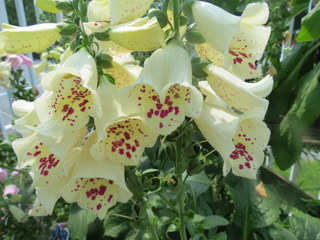Foxglove Growing Guide
Foxgloves (Digitalis purpurea) are biennials or a short-lived perennial wildflower that is native to Europe and have become naturalized in some parts of North America. Most varieties prefer part sun, with some liking full sun. Foxglove will do well in USDA Zones 4 to 9.
The flowers are bell-shaped appearing along the tall 16 to 36-inch spike. Select the variety that will suit your flower garden best. Some listed heights are: 16 to 18-inch, 24 to 36-inch, 36 to 48-inch. It will often reseed itself from the many small seeds that are released from the mature seed capsule.
The bloom colors come in various shades of yellow, white, pink and violet. The flowers appear in early summer through fall.
It is listed as being deer resistant and attracts hummingbirds, butterflies and pollinators.
Starting from Seed
Follow the seed packet instructions, seeds can be started indoors 6 to 8-weeks before your last expected frost date.
Sow the seeds in a sterile seed starting mix in cell packs or pots. Do not cover the seeds, because they need light to germinate. Press lightly into the soil and keep moist. Germination takes 15 to 20-days.
Bottom watering is the easiest way to keep moist without disturbing the newly sown seeds.
You can direct sow in your flower garden in the late spring to early summer.
For more detailed information visit the seed starting page.
Soil Preparation
Plant in part sun to full sun in a nice loose well-drained garden soil. As soon as the soil is frost-free and can be worked, till the soil by digging down 8 to 12-inches turning the soil over with a garden fork. Remove any large rocks and stones. The small stones remaining will do no harm and actually benefit the soil by adding some micro-nutrients to the soil.
Planting Foxglove
Foxglove should be planted in the late spring after the last expected frost.
Plant them 18 to 24-inches apart or in groups of 3 or 5 behind other shorter plants. Dig a hole as deep as the pot and twice as wide. To the soil you just removed add the same amount of good garden soil so you have a nice blend of new and native soil.
Take the plant out of the pot and gently loosen the root ball pulling away any roots that have grown in a circle around the pot.
Place the root ball in the hole with the growing crown of the foxglove even with or an inch higher than the surrounding soil. Gently spread out the roots and back fill the hole around the root ball leaving a shallow depression around your plant. Fill the depression with water to settle the soil around the roots adding more soil if necessary and water again. Water daily tapering off as the foxglove roots grow and get established.
Dividing Your Plants
After many years the center of the mature plant may die out, leaving the newer growth from the rhizomes. It usually becomes most apparent after a hard frost hits and the center becomes visible.
Doing the divisions every 3 to 5-years helps to rejuvenate the plant. To help prevent the spread of disease you should disinfect your garden tools and knife with a 10% bleach solution.
In the early spring about 4 to 6-weeks before the last frost date occurs and before growth begins, you can divide the clump into two, three or four sections.
Some gardeners will use a knife or a shovel to slice off a portion of the plant. A better way is to dig up the entire plant. Now you can see what you have. If you wash the soil off of the roots the entire rhizome and root structure can be seen.
Examine the rhizomes for the eyes or growing buds and carefully try to break it apart with your hands and then tease the roots apart. If necessary use a knife to separate the rhizomes.
You will now have more new plants that are identical to each other to replant or give away.
Watering and Care
They are low maintenance and easy to care for. All you need to do is add a layer of mulch to help retain moisture and keep out competing weeds. Your foxglove should get an inch of water each week and during dry spells give some water to keep the soil moist. They usually do not need any fertilizer, but a light side dressing of organic fertilizer such as Espoma Flower-tone can be placed around the plant in the spring.
Diseases and Pests
Foxglove does not have any serious disease or pest problems. Powdery mildew and leaf-spot may occur and can be treated with a fungicide. Watering at the bottom, keeping water off of the leaves will help, as well as increasing air circulation.
Aphids and mealybugs can be controlled with insecticidal soap. Japanese beetles may occur and can be controlled by hand picking early in the morning. Hold a container of soapy water under the Japanese beetle and then tap the leaf or flower and it will usually drop into the soapy water.
Popular Varieties
Popular foxglove varieties: Camelot Lavender, Camelot Rose, Camelot White, Candy Mountain, Dalmation Crème, Dalmation Peach, Dalmation Purple, Foxlight Plum Gold, Goldcrest, Polkadot Princess, Snowy Mountain, Spice Island.
Sources: Burpee, Eden Brothers, Park Seed
Tips and Warnings
The leaves and seeds of the foxglove plant are poisonous. The drug Digitalis, which is used in the treatment of heart conditions, is derived from the foxglove leaves and seeds. It is considered safe to handle the plant, but do not eat any part of it. Some references say to always to wear gloves when handling foxglove.
Garden Spikes newsletters give you timely information once or twice a month. Subscribe Free to the Garden Times newsletter below.
Your email address will only be used to send you a newsletter and will never be sold. You can unsubscribe at any time.

